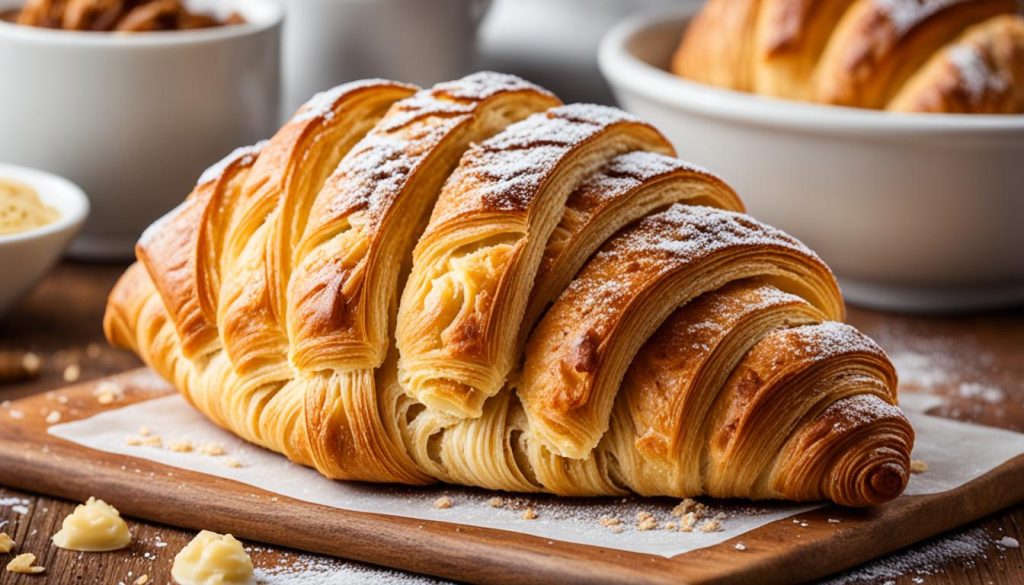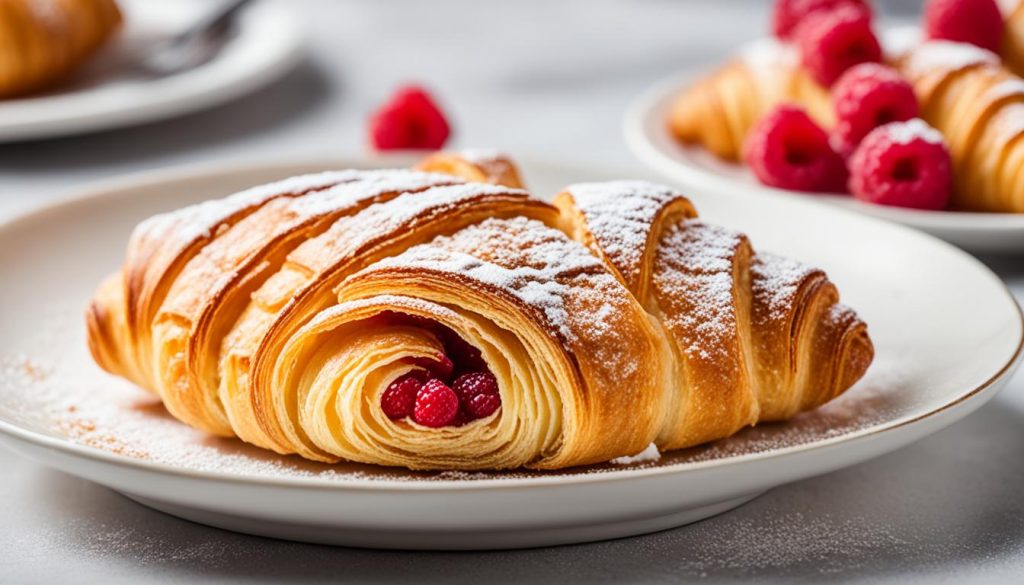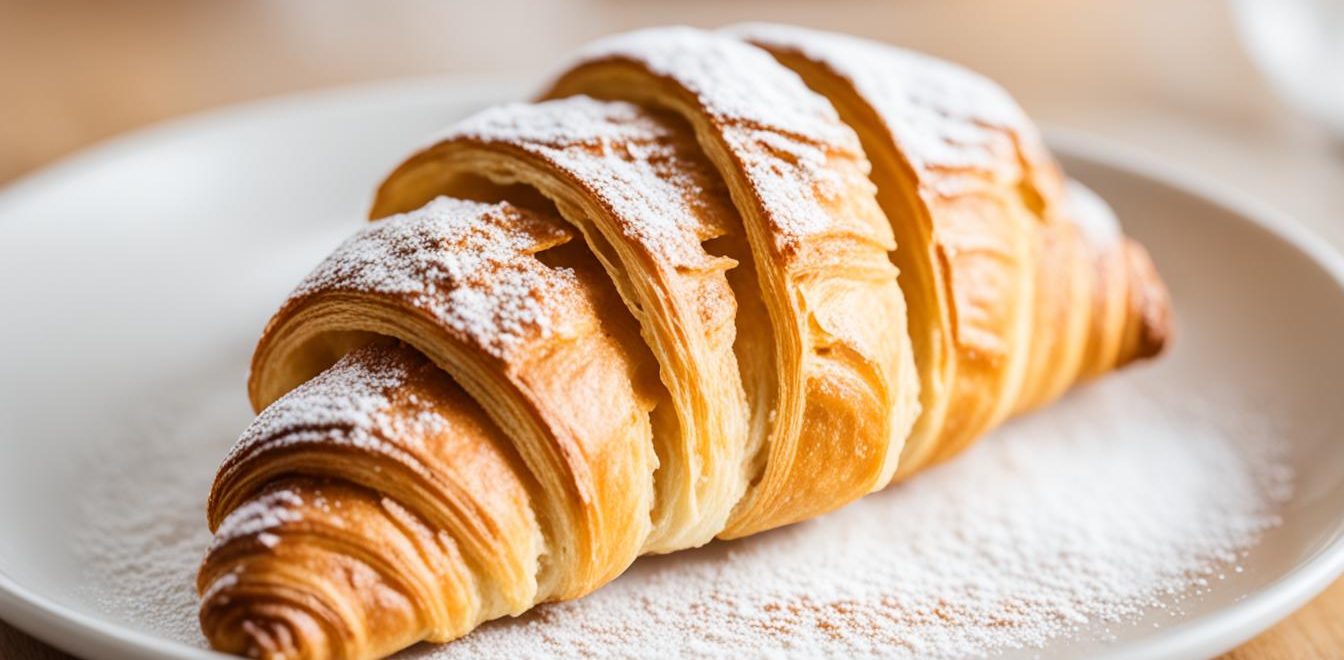Have you ever wondered how to recreate the decadence of authentic French pastries right in your own kitchen? Contrary to popular belief, you don’t need to be a professional pastry chef to master the art of French patisserie. With the right recipes and techniques, even beginners can create delicious and traditional French pastries that rival those from a French bakery.
So, are you ready to embark on a culinary journey and discover the secrets behind these mouthwatering treats? Prepare yourself for a delightful adventure filled with buttery croissants, silky crème brûlée, and more. Get your apron and rolling pin ready because we’re about to dive into the world of French pastry recipes and essential techniques that will unlock the artistry of the French bakery.
The History and Heritage of French Pastry
French pastry is not just a delicious treat; it is a reflection of the rich history and culinary heritage of France. For centuries, the art of French patisserie has been passed down through generations, with each pastry representing the skill, craftsmanship, and traditions of French bakers.
From the iconic croissants found in Parisian cafes to the delicate macarons showcased in French patisseries, every pastry tells a story. Traditional French pastries are a testament to the dedication and love that goes into creating these delectable treats.
French bakeries, also known as patisseries, are beloved institutions in France. These establishments have become synonymous with gourmet French pastries, offering a wide variety of mouthwatering treats to satisfy every craving.
But French pastry is not just about taste. It is an art form that combines precision, technique, and creativity. Each pastry requires meticulous attention to detail, whether it’s achieving the perfect flakiness in a croissant or creating the smooth and delicate texture of a macaron.
Through centuries of tradition, French bakers have perfected their craft, and their expertise is evident in the incredible delicacies that grace the display cases of French bakeries around the world.
The Evolution of French Pastry
French pastry has evolved over time, influenced by cultural and historical changes. Pastry chefs have experimented with flavors, ingredients, and techniques, resulting in a wide array of regional specialties and innovative creations.
Yet, despite these innovations, the core principles of French pastry remain the same. It is about using the finest ingredients, paying attention to every detail, and creating a harmonious blend of flavors and textures that delight the senses.
The Artistry of French Pastry
French pastry is not just about satisfying a sweet tooth; it is a feast for the eyes as well. From exquisite cakes adorned with intricate sugar decorations to beautifully crafted tarts and pastries, the visual appeal of French pastries is undeniable.
The attention to detail and the artistic presentation of these pastries are a testament to the creativity and skill of French bakers. Each pastry is a work of art, designed to captivate and enthrall.
Whether you are enjoying a classic croissant or indulging in an avant-garde creation, every bite of a French pastry is a sensory experience that transports you to the bustling streets of Paris or the cozy patisseries of the French countryside.
French pastries are more than just a sweet treat; they are a celebration of France’s culinary heritage and the mastery of French bakers. With their rich history, exquisite flavors, and stunning aesthetics, French pastries continue to captivate our taste buds and fill our hearts with joy.
Essential Techniques for French Pastry
Mastering the art of French pastries requires a solid foundation in essential techniques. These techniques lay the groundwork for creating authentic and delicious treats that will transport you to the streets of Paris. From precise measurements and weighing ingredients to mastering the art of making different types of pastry doughs, such as pâte sablée and pâte feuilletée, each step is crucial for achieving the perfect texture and flavor.
When it comes to French pastry, attention to detail is key. The precise measurements ensure that the delicate balance of flavors is maintained, while weighing ingredients accurately guarantees consistent results. This level of precision makes all the difference in achieving the desired texture and taste.
Creating different types of pastry doughs is an art in itself. For example, pâte sablée is a sweet, crumbly dough commonly used for tarts and tartlets. On the other hand, pâte feuilletée is a French puff pastry with layers of butter that result in a light and flaky texture. Knowing how to work with these types of doughs will allow you to create a variety of traditional French pastries.
Additionally, understanding the art of tempering chocolate is essential for achieving a smooth and glossy finish. Whether you’re planning to dip eclairs in chocolate or create intricate chocolate decorations, proper tempering ensures that the chocolate sets beautifully and adds an extra touch of elegance to your creations.
Smooth and silky custards and creams are the heart and soul of many French pastries. Mastering the technique of creating these luscious fillings will elevate your desserts to a whole new level. Whether it’s the creamy vanilla-scented crème pâtissière or the rich and velvety chocolate ganache, these custards and creams infuse each bite with decadence.
Essential Techniques for French Pastry:
- Precise measurements and weighing ingredients
- Mastering different types of pastry doughs
- Tempering chocolate for a smooth and glossy finish
- Creating smooth and silky custards and creams
By honing these essential techniques, you’ll be well on your way to creating authentic and artisan French pastries that will impress even the most discerning palates. So put on your apron, gather your ingredients, and let the magic of French pastry transport you to a world of exquisite flavors and textures.
Classic French Pastry Recipes
Dive into the world of classic French pastry recipes and explore the iconic treats that have delighted taste buds for centuries. From crispy and buttery croissants to decadent crème brûlée, these recipes capture the essence of French patisserie. With step-by-step instructions, you’ll be able to recreate these beloved pastries in your own kitchen and experience the flavors of France.
Whether you’re looking to impress your friends and family with a batch of flaky, golden croissants or indulge in the rich and creamy delight of crème brûlée, these classic French pastry recipes are sure to elevate your baking game. The secrets of the French bakery will now be at your fingertips as you unlock the techniques and flavors that have made French pastries world-renowned.
Take your taste buds on a journey through France as you savor each bite of your homemade gourmet French pastries. A warm, freshly baked croissant paired with a cup of coffee is the perfect way to start your mornings. And for dessert, a silky-smooth crème brûlée with its caramelized sugar crust is an exquisite finale to any meal.
Traditional French pastries have stood the test of time with their delicate textures, buttery flavors, and beautiful presentations. By following these classic French pastry recipes, you’ll not only delight yourself but also impress your loved ones with your culinary skills. So put on your apron, preheat the oven, and let the aroma of freshly baked French pastries fill your home.
The Delightful Recipes to Try:
- Authentic French croissants
- Classic pain au chocolat
- Delicate macarons
- Butter-rich madeleines
Get ready to embark on an exquisite culinary adventure with these French pastry creations. Let your imagination soar as you experiment with different flavors and fillings to create your own signature French pastries. With every bite, you’ll be transported to the charming streets of Paris, where the aroma of freshly baked pastries wafts through the air.
Bring the joy of the French bakery into your home, and become a master of French patisserie with these classic pastry recipes.
The Secrets of Laminated Dough: Croissants and More
Laminated dough serves as the foundation for many traditional French pastries, including the beloved croissants and delicate puff pastry treats. The exquisite layers and buttery texture are what make these pastries truly exceptional. Unlocking the secrets behind laminated dough will empower you to create these artisan French pastries right in your own kitchen.
Creating laminated dough involves a precise technique called “turning,” which alternates layers of butter and dough to create a light and flaky texture. Mastering this technique is key to achieving the perfect croissant or puff pastry.

The Process of Making Laminated Dough:
- Start by preparing the basic dough by combining flour, water, salt, and a touch of sugar.
- Roll out the dough into a rectangular shape and place chilled butter in the center.
- Fold the dough over the butter, encasing it completely.
- Roll out the dough and perform a series of turns, folding it into thirds, refrigerating between each turn.
- Repeat the rolling and turning process several times until you achieve the desired number of layers.
- After the final turn, chill the dough and then shape it according to your recipe’s instructions.
- Bake until golden brown and enjoy the delightful flakiness of your homemade croissants or puff pastry wonders.
With practice and patience, you’ll be amazed at the results you can achieve with laminated dough. Transforming a few simple ingredients into these classic and delicate pastries will undoubtedly impress your friends and family.
Mastering Chocolate Decorations: A Touch of Elegance
French pastry recipes are known for their exquisite flavors and beautiful presentations. One way to elevate your artisan French pastries to the next level is by mastering the art of chocolate decorations. These elegant and sophisticated additions not only add visual appeal to your creations but also enhance the overall taste experience.
One of the essential techniques in working with chocolate is tempering. Tempering chocolate ensures that it has a smooth and glossy finish with a crisp snap. To temper chocolate, you’ll need to heat and cool it to specific temperatures while stirring it continuously. This process stabilizes the chocolate and enables you to create beautiful decorations that not only look amazing but also taste incredible.
Once you have tempered chocolate, you can unleash your creativity and start making intricate designs. From delicate chocolate curls to piped patterns, the possibilities are endless. You can use molds to create impressive shapes or freehand techniques to add a personal touch to your pastries.
Whether you’re decorating a cake, piping chocolate drizzles, or creating sculptural elements, precision is key. The skillful execution of these chocolate decorations adds a touch of sophistication and elegance to your gourmet French pastries. With practice and patience, you’ll be able to impress your friends and family with your artistic creations.
Remember, chocolate decorations should not only look good but also taste delicious. High-quality chocolate and your attention to detail will ensure that your decorations are not just visually stunning but also contribute to the overall flavor profile of your artisan French pastries.
Elevating Your Pastries with Custards and Creams
French pastry is known for its luscious custards and creams. These delectable fillings add a velvety smoothness and a burst of flavor to your favorite pastries. Mastering the art of tempering eggs and mastering the cooking techniques for creating smooth and silky custards and creams is essential for a truly indulgent experience.
When making French custards and creams, it is important to use high-quality ingredients such as fresh eggs, rich cream, and fragrant vanilla. The delicate balance of flavors is what makes these fillings so special.
Tempering Eggs: The Secret to Silky Custards
Tempering eggs is a crucial technique when making custards. It involves gradually adding a hot liquid to beaten eggs to raise their temperature slowly, preventing them from curdling. To temper eggs for custards, follow these steps:
- In a saucepan, heat the liquid component of your custard (milk, cream, or a combination) over medium-low heat until steaming but not boiling.
- In a separate bowl, whisk together the egg yolks and sugar until pale and creamy.
- Slowly pour a small amount of the hot liquid into the egg mixture while whisking continuously. This will raise the temperature of the eggs without cooking them.
- Continue whisking and gradually add the rest of the hot liquid to the egg mixture.
- Return the mixture to the saucepan and cook over low heat, stirring constantly with a wooden spoon, until the custard thickens and coats the back of the spoon.
- Remove the custard from the heat and strain it through a fine-mesh sieve to remove any lumps.
Tempering is a skill that may take practice, but once mastered, it will ensure that your custards are smooth and velvety every time.
Creating Smooth and Silky Pastry Creams
Pastry creams are a versatile filling used in many French pastries, such as éclairs, cream puffs, and fruit tarts. Follow these steps to create a smooth and silky pastry cream:
- In a saucepan, heat the milk and vanilla bean (or extract) until steaming. Remove from heat and let it steep for about 15 minutes to infuse the milk with vanilla flavor.
- In a separate bowl, whisk together the sugar, egg yolks, and cornstarch until well combined.
- Slowly pour the hot milk into the egg mixture, whisking continuously.
- Return the mixture to the saucepan and cook over medium heat, stirring constantly with a wooden spoon until the cream thickens and comes to a gentle boil.
- Once the cream has thickened, remove it from the heat, and strain it through a fine-mesh sieve to remove any lumps.
- Allow the pastry cream to cool completely before using it as a filling for your pastries.
Custards and creams are a delightful way to elevate your pastries, adding a luxurious texture and a burst of flavor. Whether you’re making crème anglaise, crème pâtissière, or other pastry creams, mastering these techniques will take your French pastries to new heights of deliciousness.
Exploring Regional French Pastries
France is a country known for its rich culinary heritage and exquisite pastries. Each region in France has its own unique pastry specialties that reflect the local flavors, traditions, and techniques. Exploring regional French pastries is like embarking on a delicious journey through the diverse landscapes and cultures of this beautiful country.
One famous regional pastry is the kouign-amann from Brittany. This buttery and caramelized pastry is made with layers of dough and sugar, resulting in a crispy and flaky texture. Born in the coastal region of Brittany, this delightful pastry showcases the region’s affinity for butter and simplicity in its ingredients.
In the picturesque Loire Valley, you’ll find the delicate and indulgent tarte Tatin. This upside-down caramelized apple tart is a true French classic. Its origins can be traced back to the Tatin sisters, who accidentally created this delectable dessert when trying to rescue a caramelized apple pie gone wrong. Now, it is a beloved dessert synonymous with the Loire region’s food culture.
As you explore the diverse regional French pastries, you’ll encounter a multitude of flavors, textures, and techniques. From the fruity fraisier cake of Alsace to the decadent galette des rois (king cake) of Provence, each region offers its own twist on French patisserie.
By expanding your repertoire and trying these regional delights, you’ll gain a deeper appreciation for the diversity and creativity within the world of French pastries. Whether you’re a passionate home baker or an aspiring pastry chef, exploring regional French pastries will inspire you to experiment with different flavors and techniques in your own kitchen.
The Flavors of the Regions
- Brittany: Kouign-amann, a rich and buttery pastry
- Loire Valley: Tarte Tatin, a caramelized upside-down apple tart
- Alsace: Fraisier, a strawberry cake
- Provence: Galette des rois, a king cake
These are just a few examples of the regional pastries you can discover on your gastronomic journey through France. Each bite will transport you to a different part of the country, offering a taste of its history, culture, and culinary traditions.
So, indulge your sweet tooth and embark on a flavorful adventure as you explore the regional French pastries. From the richness of Brittany to the elegance of the Loire Valley, the artistry and diversity of French patisserie await.
Modern Twists on French Classics
While traditional French pastries are beloved classics, it’s always exciting to add a modern twist to these timeless favorites. By incorporating new flavors, techniques, and ingredients, you can create innovative and unique French pastries while still honoring the essence of traditional patisserie.
Take a culinary journey and explore the realm of modern French pastry recipes. Experiment with unexpected combinations, ingredients, and presentation styles to create a fresh take on classic treats. Let your creativity shine as you infuse traditional French pastries with your own personal touch.
Imagine a delicate chocolate éclair infused with lavender, or a flaky croissant adorned with a fusion of cardamom and orange zest. These modern twists on French classics provide an opportunity for you to express your individuality and culinary prowess.
Step out of your comfort zone and try recipes that push the boundaries of traditional French pastries. Explore the use of exotic fruits, spices, and alternative flours to create unique flavor profiles. Try experimenting with decorating techniques, such as using edible flowers or incorporating vibrant colors, to elevate your pastries’ visual appeal.
The evolution of French patisserie doesn’t mean abandoning tradition but rather reinterpreting it for a modern palate. By embracing innovative flavors and techniques, you can create artisan French pastries that captivate both the eye and the taste buds.
Unleashing Your Creativity
If you’re unsure where to start with your modern twists, here are a few ideas to spark your imagination:
- Add a hint of spice to classic French macarons, such as chai or matcha.
- Experiment with savory elements in your pastry creations, like bacon and cheese in a flaky tart.
- Infuse delicate pastry creams with unique flavors, like rosewater or Earl Grey tea.
- Create unexpected combinations by pairing traditional French fillings with exotic fruits, such as mango or passionfruit.
- Explore new textures by incorporating nuts, seeds, or crunchy toppings into your pastries.
Remember, the key is to strike a balance between innovation and honoring the artistry of traditional French patisserie. Paying homage to the classics while embracing your creativity will allow you to craft modern French pastries that are both delicious and visually stunning.
So, get inspired, grab your apron, and embark on a journey of culinary experimentation. Mix traditional French pastry techniques with modern twists, and watch as your creations delight both your taste buds and amaze your guests.

Tips and Tricks for Successful French Pastry
Mastering the art of French pastry requires practice, attention to detail, and a touch of finesse. Fortunately, experienced pastry chefs have generously shared their valuable tips and tricks to help you achieve outstanding results in your own patisserie creations. Whether you’re an aspiring pastry chef or a passionate home baker, these insider insights will guide you towards creating perfect French pastries every time.
1. Use high-quality ingredients: Start with the finest ingredients available to ensure the best flavor and texture in your pastries. Opt for fresh eggs, high-quality butter, and pure vanilla extract for the most authentic and gourmet French pastries.
2. Measure accurately: Precision is key when it comes to French pastry. Invest in a reliable kitchen scale to measure ingredients by weight, especially for delicate recipes like macarons. This will ensure consistent results and professional-quality pastries.
3. Handle butter with care: Butter plays a crucial role in French pastries, providing richness and flavor. To achieve flaky layers, use cold butter and incorporate it into the dough or pastry as instructed. Avoid overworking the butter to prevent it from melting and compromising the texture of your pastries.
4. Chill the dough: Many French pastry recipes require chilling the dough before rolling or shaping. This step allows the butter to firm up, resulting in light and delicate pastries. Follow the recipe instructions and resist the temptation to skip this important step.
5. Don’t rush the proofing process: Give your pastries enough time to rise and proof. This step is crucial for achieving a light and airy texture. Follow the recommended proofing times provided in the recipe and allow the dough to double in size before proceeding with baking.
6. Bake with precision: Pay close attention to baking temperatures and times. French pastries often require precise baking to achieve the desired crispness or tenderness. Invest in a reliable oven thermometer to ensure accurate temperature readings and adjust as necessary.
7. Be patient: French pastries can be time-consuming, but the result is worth the effort. Take your time, follow the recipe instructions carefully, and enjoy the process. The slow and deliberate approach is what sets artisan French pastries apart from mass-produced alternatives.
8. Experiment with flavors: While there’s always a place for traditional French pastries, don’t be afraid to experiment with flavors and add your own twist. Consider incorporating seasonal fruits, aromatic spices, or unique extracts to create gourmet French pastries that surprise and delight.
With these tips and tricks in your baking arsenal, you’re well on your way to mastering the art of French pastry. Embrace the craftsmanship, savor the flavors, and let the beauty of artisan French pastries shine through in your creations.
Conclusion
French pastries are a true culinary art form, known for their delicate textures, exquisite flavors, and elegant presentations. The journey of mastering the art of creating authentic French pastries may seem intimidating at first, but with the right recipes, techniques, and a passion for patisserie, anyone can achieve delicious results.
By exploring the rich history and heritage of French pastry, you can gain a deeper appreciation for these traditional delicacies and the craftsmanship behind them. Mastering essential techniques such as creating different types of pastry doughs and perfecting custards and creams is essential to achieving the authentic flavors and textures of French patisserie.
With classic recipes as your guide, you can start experimenting in your own kitchen and experience the joy of creating French pastries. Whether you’re making buttery croissants, indulgent crème brûlée, or exploring regional specialties, the art of French patisserie invites you to embrace your creativity and immerse yourself in the flavors of France. So, don your apron, gather your ingredients, and let the art of French patisserie inspire your baking adventures. Bon appétit!
Source Links
- https://www.everand.com/book/641500495/Patisserie-at-Home-Step-by-step-recipes-to-help-you-master-the-art-of-French-pastry
- https://www.bakerykart.com/baking-world-blog/blog-detail/baking-trends/the-art-of-french-pastry-mastering-classic-techniques-and-recipes
- https://www.goodreads.com/book/show/17345201-the-art-of-french-pastry






